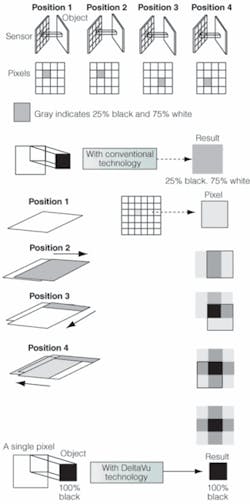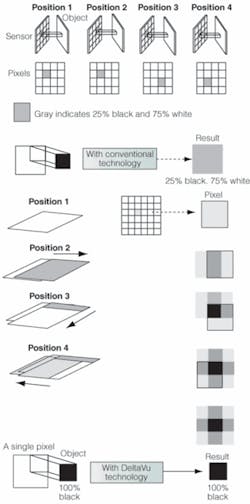Pixel shifting increases microscopy resolution
Andrew Wilson, Editor, [email protected]
Traditional pixel-shifting technology enhances resolution by moving the image sensor typically half of a pixel between each image capture, sampling the object at more locations, and using these extra captured pixels directly as image data. The increase in resolution of this technique is limited to the point where the active area of a given pixel begins to overlap with the pixel in the previous position. As the active area increases, the object starts to become over sampled and moving the sensor captures no new spatial information.
To demonstrate the traditional method of capturing and combining multiple images, a 4 × 4 matrix can be used to represent the digital camera’s image sensor (see figure). Here, the object being imaged is a black dot that is one quarter of the size of one of the image sensor’s pixels. After an initial image is captured, the sensor is moved to the left by half a pixel and another image captured. A third image is captured after moving the sensor up by half a pixel to a third position. Finally, a fourth image is captured after moving the sensor to the right by half a pixel to a fourth position. However, because the black dot is only one-quarter the size of the pixel detecting it, the pixel will image it as light gray-a mixture of 25% black and 75% white. Combining the four images results in an oversampled image with four times the number of pixels but no increased spatial detail.
To overcome these limitations, Lumenera (Ottawa, ON, Canada; www.lumenera.com) has developed DeltaVu, a patent-pending method that uses subpixel shifting technology to increase image resolution. The first product featuring the technology is the Infinity X USB microscope camera, which achieves 21-Mpixel resolution through shifting the 1280 × 1024-pixel array of a 1/2-in. color sensor. Under software control, 1-, 3-, 5-, 12-, and 21-Mpixel resolution can be selected. Using the technology ensures that all primary colors (RGB) are represented in each pixel for precise color reproduction.
“Because the Infinity X shifts the sensor a fraction of a pixel between each image capture, the result is a large amount of overlap between neighboring pixels for each image captured,” says Drew Buttress, director of business development at Lumenera. “Knowing the precise location of each subpixel shift, images containing greater detail and enhanced color clarity are achieved. Objects much smaller than the size of an individual pixel can be resolved with no interpolation artifacts. In theory, by adjusting the amount of pixel overlap, the resolving power can be increased without limit. In practice, however, the resolution is restricted by the resolving power of the optical system.”
The Infinity X makes use of DeltaVu technology to interpret and combine the information from multiple images (see figure on p. 23). The image captured in position two is placed on top of the image captured in position one and then shifted half a pixel to the left. The result is a darker area (pixel), where the gray pixels overlap each other. The process is repeated for the images captured in positions three and four, where one image is placed on top of another other and shifted half a pixel. This results in a combined image with one darker pixel, where the two gray pixels overlap each other.
Next, the two combined images are placed on top of each other and shifted down by half a pixel. The combination of all four images will have one black pixel (where the four gray pixels overlap each other), four dark gray pixels (where only two gray pixels from the original images overlap each other), and four light gray pixels (where no pixels overlap).
“With four movements, the final Infinity X image is a single isolated black pixel with a resolution four times higher than the number of active pixels in the sensor. This resolution can be increased through additional subpixel movements of the sensor until the limits of the resolving power of the optics are reached,” Buttress adds.

